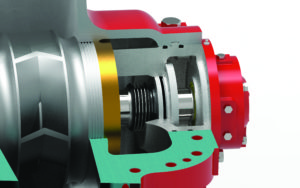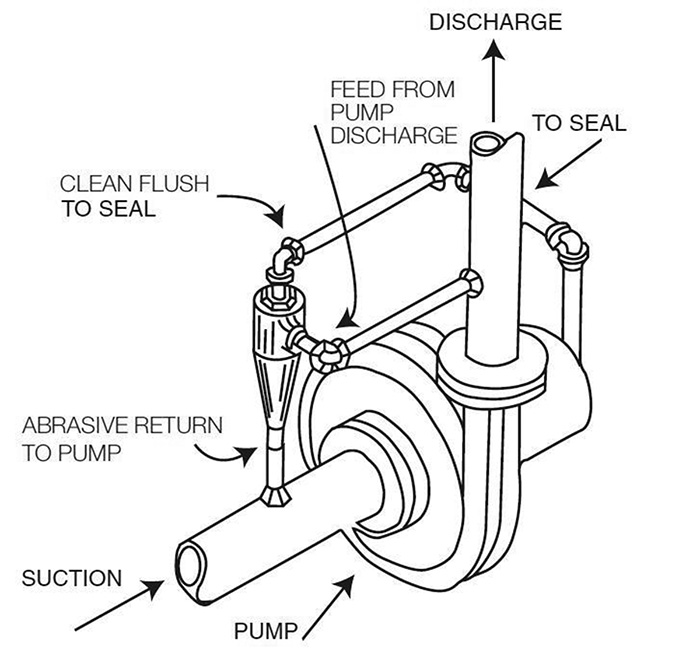 How do you match the mechanical seal specification of double suction pumps with the scheduled base bid manufacturer and allow other names in the spec? How do I know what seal I need for my application? This is the subject of this week’s R L Deppmann Monday Morning Minutes.
How do you match the mechanical seal specification of double suction pumps with the scheduled base bid manufacturer and allow other names in the spec? How do I know what seal I need for my application? This is the subject of this week’s R L Deppmann Monday Morning Minutes.
One of the more frequent standards in our industry is an attempt to get three or more equal bids on everything. Creating an equal specification that three pump manufacturers can meet gets complicated if one of them, like B&G, is improving and enhancing the owner benefits of its product. In the following article, I will identify benefits and materials of construction, but also show some acceptable alternates. We’ll look at the B&G series VSX and e-HSC double suction split case pumps.
The subjects will be:
- Mechanical seals and flushing options specifications
- Impellers, bearings, shafts, and wearing rings
- Bases and couplers and installation
- Pump efficiencies and specifications
So let’s look at specifications for mechanical seals.
Flushing of Mechanical Seals for Hydronic and Plumbing Systems
Pump seals require flushing for several reasons:
- removal of heat
- management of temperature caused by friction
- dirt management
Bell and Gossett designed their 175 PSIG working pressure end suction e1510 and double suction pumps including the e-HSC and VSX with internally flushed mechanical seals. The internally flushed design is a very valuable construction feature for owners. An internal flushing chamber allows for the maximum amount of water around the seal. This design also allows for the removal of sediment and solids. You can read about this in more detail in our article How to Pick an HVAC Centrifugal Pump Part 6: Internally vs. Externally Flushed Mechanical Seals.
We thank Pumps & Systems for the Photo from their March 27 2013 article.
Many of our competitors still use the decades-old stuffing box flush seals design. Sometimes under very high working pressures, Bell & Gossett also uses flush lines. What is the issue with flushing lines? Simply explained, if the water has particulate in it, we will be flushing the seal with the grit in the water. If the flushing line clogs up or the pump pressure is not great enough to provide the correct flow, the seal will be damaged and begin to leak. In the world we live in, building comfort and plumbing systems, there are four types of flushing arrangements to consider.
You can flush the seal:
- Through an internally flushed chamber. [B & G] (Plan 03)
- With externally sourced clean water. (Plan 32)
- With the water in the system that is clean enough (Plan 11)
- With the water in the system through a filter. (Plan 31)
The plan numbers refer to the seal manufacturers arrangements and terminology. Plan 03 is the Bell & Gossett owner benefit standard. Plan 11 is what you use if the water is clean such as a closed hydronic system that is relatively new. Plan 31 is what you use if you have water with sediment in it such as cooling towers or older systems. Plan 32 would take makeup water as the flushing medium which could be done in a cooling tower system.
Just a word about Plan 31 with filters and separators in seal lines. A filter similar to the Cuno™ filter is a 5 to 50 micron filter that captures the sediment before it gets to the seal. The issue is that they have to be maintained. If it plugs and the owner does not clean it you may lose the seal. Separators are just like the Griswold Water separators you get from us for use in hydronic and industrial systems. Their challenge is variable speed systems. The separators require a minimum pressure differential to work. While we save energy by reducing speed, the efficiency of the separator drops down since the pressure differential drops as the square of the flow. By the way, as the speed drops, so does the flushing GPM, so the pump supplier should verify that the flushing line will produce enough flow at the minimum speed. That is a good reason to make sure the pump supplier also provides the separator. Now you see why B&G designed and utilizes an internally flushed seal chamber!
Materials of Mechanical Seals for Hydronic and Plumbing Systems
Hydronic systems are a pretty simple service for the mechanical seal in the pump. Mechanical seals in pumps are challenged by three very specific things: dissolved solids, undissolved silica or sand, and the pH of the fluid. The first thing you should do is check your specification for chemical treatment section 23-25-00. Many of these specifications require the chemical treatment of the system to adjust the pH between 8.0 and 10.5. This is typical of federal jobs and many university projects. The issue is that this pH is outside of the recommended pH of standard seals. If this is how your spec reads, then adjust my recommendation below accordingly.
In a previous R L Deppmann Monday Morning Minute called: Mechanical Seal Materials, I spoke about the materials of construction of seals. So let’s look at the recommended wording for your specification.
- Pump shall be equipped with a pair of internally self-flushing mechanical seal assemblies (Plan 03) requiring no flushing lines. (Alternately to internally flushed mechanical seal assemblies, supply externally flushed mechanical seals including the flushing line and two cyclone separators or filters mounted in the flushing lines (Plan 31).
- For open cooling towers and systems containing glycols, the seals shall have EPR elastomers, stainless steel spring, and silicon carbide face rotating against a stationary silicon carbide face (SiC-SiC). All other seal assemblies shall contain EPR (EPT or EPDM) or Buna elastomers, stainless steel spring, carbon face rotating against a stationary silicon carbide, tungsten carbide, or ceramic face.
This specification shows a preference to the internally flushed mechanical seal if the pump manufacturer has that available. It protects against a proprietary spec by offering the use of the alternative flushing line. You may choose to eliminate the filter or separator from the flushing lines if you are comfortable with the quality of the water in the system. That would be Plan 11.
Check out our recent Monday Morning Minute, “Bell & Gossett Hits One Out of the Park with their New Double Suction Pump“.
Stay tuned for next week’s Monday Morning Minute where we’ll look at bearings and shafts in their specification.


